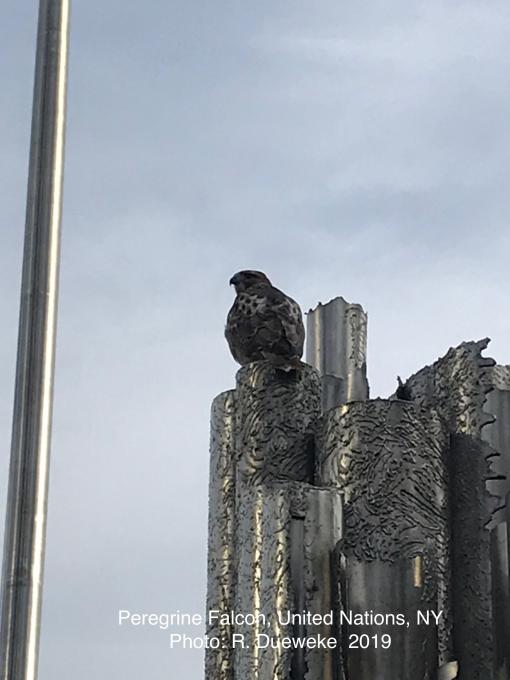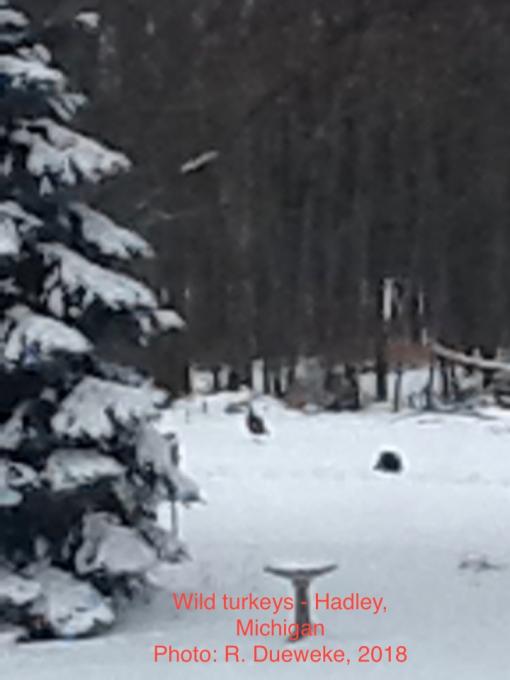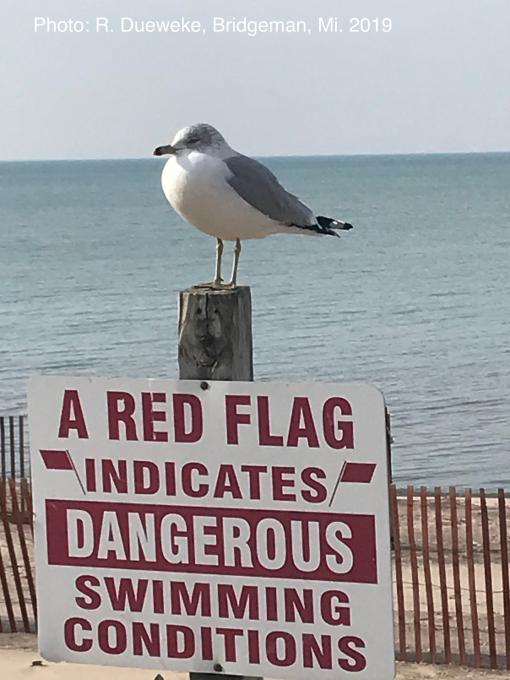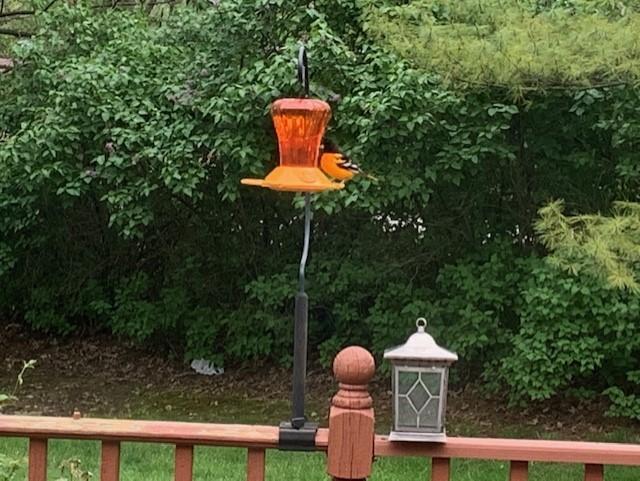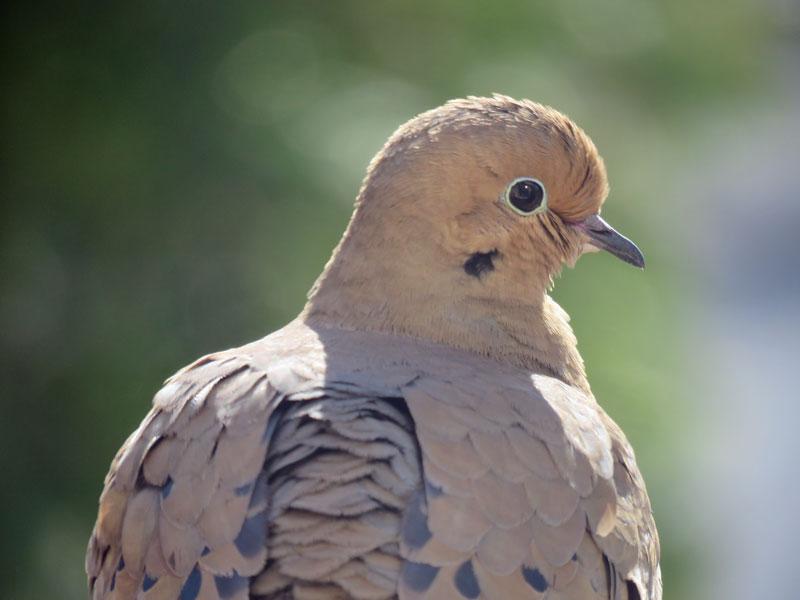The Cornell Lab Bird Academy › Discussion Groups › Joy of Birdwatching › Activities: Exploring Birds
-
Three favorite local birds from three different groups: 1. Ruby-throated Hummingbirds - I like these because they are so small and fast, it always feels special to actually be able to observe one. Last year we had many at our hummingbird feeder outside our kitchen window, and I'm really looking forward to seeing them again this summer. 2. Mourning Doves - I'm such a beginner with bird watching, that I love birds that I can easily identify by their song. These guys have such a distinct, lonely song that really reminds me of being outside as a kid. I've been hearing mourning doves around our house a lot this spring. 3. Red-winged Blackbirds - Again, a bird that has a very distinctive call, and they are pretty easy to spot in wet areas when I'm taking a walk along my road. I'm always trying to mimic bird songs, and this one I find impossible to mimic! Maybe that's why I find it so special.
-
 Hi all
Hi all
 Hi all,
I've also been enjoying the course. I've been bird watching for a few years but felt I needed a bit of structure to help me improve my skills and knowledge. I think I might be the only student so far posting from Australia! So I thought I'd show you some typical Aussie cockatoos - big loud and gorgeous birds. The gang gang (male) , the sulphur crested and lastly the biggest in my area of south west Australia - the yellow-tailed black cockatoo. I'm enjoying learning about North American birds too.
Thanks Marie
Hi all,
I've also been enjoying the course. I've been bird watching for a few years but felt I needed a bit of structure to help me improve my skills and knowledge. I think I might be the only student so far posting from Australia! So I thought I'd show you some typical Aussie cockatoos - big loud and gorgeous birds. The gang gang (male) , the sulphur crested and lastly the biggest in my area of south west Australia - the yellow-tailed black cockatoo. I'm enjoying learning about North American birds too.
Thanks Marie -
Wonderful pics of Cockatoos, Marie, and thanks for offering a down-under perspective. I visited a step-sister just north of Sydney in Jan 2019, and saw cockatoos in her backyard. I was amazed!
-
Great pics of Aussie birds! I spent a year living in Australia, and the birds were one of my favorite things about it. I bought an Australia Birds ID book, which I must still have someplace, and kept track of all the ones I saw there. Thanks for sharing!
-
-
 One of my new favorites - Carolina Wren. 1st time seen in our yard (Cape Cod, MA) last year. Found this nest in our planter box outside our front window w/ 3 - 4 chicks inside (hard to make out but just left and above the adults head - can see chick beak).
One of my new favorites - Carolina Wren. 1st time seen in our yard (Cape Cod, MA) last year. Found this nest in our planter box outside our front window w/ 3 - 4 chicks inside (hard to make out but just left and above the adults head - can see chick beak). -



-
Hello Fellow Birders: I have always loved nature but did not get into bird watching until about two years ago when my husband and I moved to San Antonio, Texas. We have about an acre in the back, fenced and with lots of old oaks and elms. I first noticed the Northern cardinals since I had not seen them before, and they are so striking, as we all know. But what really got me interested is when a Carolina wren couple decided to build their nest in a hanging flower basket right outside one of the doors to our back patio. I watched them build the nest, hatch the eggs, feed the li'l ones and then, finally, watched the four chicks take their first flight. They hung around for some time longer so I also saw them grow. I felt like a grandmother! Since then the Carolina wren has been my absolute favorite bird. Signing up for this course is my first step into becoming a more serious birder. I have a few identification guides and a pair of binoculars that I have been using these last two years. So far, I have managed to identify about 50 species just in my backyard! But learning more about birds is an exciting prospect. And sharing with y'all online is a great way to start since we are now limited in our interactions in the outside world. Paivi
-
Activity #1~ The artistic work on the 'Wall of Birds' from throughout the world is amazing. I'm a complete novice to bird watching. My interest can be attributed to a couple events. The first is the 'quarantine', and the second was two mourning doves selecting a fern hanging outside my sliding glass door for their nest site. I perused the 'Wall of Birds', and learned a great deal about a variety of different birds from this planet. My favorite was probably the barn owl because of learning about its incredible hearing. I always assumed owls had huge pupils in their eyes, which enabled them to hunt at night. I didn't realize how much hearing plays apart in that endeavor. Activity #2~ I utilized a field guide to read about local birds including Mallard ducks (which I have), and other birds like the Arctic Tern. I've never seen this bird, but their migration rivals miles traveled by career commercial airline pilots! I 'inherited' the National Geographic Birds of North America, but since participating in this course, I've ordered Peterson's Field Guide to Birds in North America, and The Sibley Guide to Birds. I utilized the first to do this activity because the others hadn't arrived yet. Activity #3~ Favorite Bird? Mourning Doves literally stole my heart. Two mated Mourning Doves selected a fern outside my sliding glass door as their nesting site. I was bringing my outdoor plants inside because of a drop in temperature (Indianapolis). When I started to bring the fern into the house; I discovered a bird in the nest. I took a picture, and utilized the Merlin Bird ID provided by Cornell. I discovered it was a Mourning Dove (already admitted I'm a complete novice). I watched the bird for several days, which was about 8 feet from my dining room table. What I discovered through reading a guide was Mourning Doves (both males and females) assume responsibility in caring for their eggs. It was explained that the male and female look very similar (especially to untrained eyes). As a result, it appears to be the same bird on the nest at all times. The information was correct, I was blessed to witness the 'switch' on several different occasions. As the literature mentioned, the Mourning D
 oves are not great nest builders. However, they more than make up for that as parents. I mowed my lawn twice during the incubation period, and the female never moved off the nest. One night, we had a very strong front move through with high winds. I was concerned because the nest (in the fern) was supported by a hook on the deck. The wind rocked the fern back and forth, but the male never moved off the nest. I was blessed to watch the two baby doves grow, and be feed by both parents. They have now left the nest, and are staying under low hanging vegetation, and the mother still visits. I think she's still feeding them, and they are definitely getting bigger & exercising their wings for short trial flights. Bottom line.....I'm leaving the fern out with the abandon nest hoping they will select it again. They not only 'hooked' me on Mourning Doves; they also hooked me on bird watching! My many thanks to the Bird Academy for this opportunity, and I've recommended it to several friends and family members. ~ Jeff
oves are not great nest builders. However, they more than make up for that as parents. I mowed my lawn twice during the incubation period, and the female never moved off the nest. One night, we had a very strong front move through with high winds. I was concerned because the nest (in the fern) was supported by a hook on the deck. The wind rocked the fern back and forth, but the male never moved off the nest. I was blessed to watch the two baby doves grow, and be feed by both parents. They have now left the nest, and are staying under low hanging vegetation, and the mother still visits. I think she's still feeding them, and they are definitely getting bigger & exercising their wings for short trial flights. Bottom line.....I'm leaving the fern out with the abandon nest hoping they will select it again. They not only 'hooked' me on Mourning Doves; they also hooked me on bird watching! My many thanks to the Bird Academy for this opportunity, and I've recommended it to several friends and family members. ~ Jeff -
It was great getting to hear your story Jeff! I'm also pretty new to birding and got into it thanks to the Mourning Dove and nesting birds too! For the longest time I thought that I was hearing an owl, and finally discovered it wasn't when I looked it up! Also, a Northern Cardinal nested right outside our window (it was hard to identify since the female is mostly brown), and we got to see the dad when the babies hatched!
-
@William I got interested in birding, too, because of mourning doves nesting in my rain gutter. I've watched the doves build their nest, lay eggs, birth 2 hatchings, and saw what I call the 'changing of the guard' of the mother and father every afternoon. Saw the first flight of a hatching! The virus lockdown kept me home and able to spend time in my backyard, sparking my interest in birds and watching the dove family all day, every day. The doves are still here. Read everything I could about mourning doves, but this class has broadened my world of birding. Love it!
-
Thanks for the nice story.
-
-
Hi there! I found it interesting to learn about how to group the birds because that really helps me learn and remember the birds. I had some questions about how to group the following songbirds that I've recently seen:
- American crow
- Blue jay (they go with crows, right?)
- Carolina wren
- Tufted titmouse
- Gray catbird
- Eastern towhee
- Northern mockingbird (they go with thrashers, right?)
- Blue gray gnatcatcher
- Eastern bluebird (I assume they go in "other" like the western bluebird?)
-
I have been feeder watching in Washington State many years but most of them east of the Cascade Mountain range. Now I'm in the Seattle area and I'm having to learn new birds and new songs so I am taking the classes to improve my skills. Some of my favorite birds in Spokane were Pygmy Nuthatches which fledged their young for several summers in a birch snag I left standing in my garden and the California Quail who were so comical, especially in snow. Now I am enamored with Pileated Woodpeckers and Bewick's Wrens (pronounced like the Buick car, I learned). My first love is gardening so I try to make my garden as welcoming as I can and have attracted many different birds that way. The wonderful pictures inspire me to take the time to try for some good photographs. My biggest bird thrill since I moved was to see a Western Tanager.
-
 The material so far has been helpful and I look forward to the rest of the course. We live close to the river and a nesting site for a Raven pair. Over the years we have watched their antics in the wind, listened to the diversity of their calls - including their rapid "hawk, Hawk" when a hawk or eagle comes too close to home. Also, watching the training of the young birds is fascinating and entertaining.
The material so far has been helpful and I look forward to the rest of the course. We live close to the river and a nesting site for a Raven pair. Over the years we have watched their antics in the wind, listened to the diversity of their calls - including their rapid "hawk, Hawk" when a hawk or eagle comes too close to home. Also, watching the training of the young birds is fascinating and entertaining. -
This time of year, American Goldfinches flock to the bird feeders on my crabapple tree. As spring progresses, the males change from dull to intense yellow in coloring -- a spectacular display right out my window.
-
 Activity 3
We went out to the ocean during the winter to see what birds we could see. We saw a relative (Pacific Loon) of my favorite the Common Loon. Being from Minnesota I fell in love early with our State Bird, and I would hear it sometimes during the night singing one of it's three beautiful songs. I never forgot those nights, and they are back at the lake now, and I can hear them again. I can't get a picture, they are so shy.
Activity 3
We went out to the ocean during the winter to see what birds we could see. We saw a relative (Pacific Loon) of my favorite the Common Loon. Being from Minnesota I fell in love early with our State Bird, and I would hear it sometimes during the night singing one of it's three beautiful songs. I never forgot those nights, and they are back at the lake now, and I can hear them again. I can't get a picture, they are so shy.
 When we went to Lincoln, NE, for my aunt's funeral, I was terribly sad. I thought I would visit a museum to feel better. I did, and it helped, but as I pulled out of the parking lot, I thought I saw a crumpled paper bag in front of the museum. I kept watching, and soon realized it wasn't a bag but a Red- Tailed Hawk greedily eating a red squirrel. I stopped & got my camera and began taking pictures. He continued eating. I quietly exited the car & continued taking pictures with my long lens. After he finished his meal he flew off to watch for another red squirrel. It was as if the hawk told me good bye from my aunt.
When we went to Lincoln, NE, for my aunt's funeral, I was terribly sad. I thought I would visit a museum to feel better. I did, and it helped, but as I pulled out of the parking lot, I thought I saw a crumpled paper bag in front of the museum. I kept watching, and soon realized it wasn't a bag but a Red- Tailed Hawk greedily eating a red squirrel. I stopped & got my camera and began taking pictures. He continued eating. I quietly exited the car & continued taking pictures with my long lens. After he finished his meal he flew off to watch for another red squirrel. It was as if the hawk told me good bye from my aunt.
 This little guy came to visit us the minute we put the hummingbird feeder out. I think it is an Anna's. She stayed on through the fall and all winter. When it got cold, we'd have two feeders ready in case one froze up. We'd run out grab the frozen one and put out the warm one up from the kitchen. The minute we's turn our back to go in, she was there, sucking away. We think her great-great-great-great grandchildren are still with us, although not as unafraid as she was, and they stay year around, just like her.
This little guy came to visit us the minute we put the hummingbird feeder out. I think it is an Anna's. She stayed on through the fall and all winter. When it got cold, we'd have two feeders ready in case one froze up. We'd run out grab the frozen one and put out the warm one up from the kitchen. The minute we's turn our back to go in, she was there, sucking away. We think her great-great-great-great grandchildren are still with us, although not as unafraid as she was, and they stay year around, just like her. -
 I think this may be a Gray Jay seen while walking along the shore of Lake Ontario , near the Humber River close to Toronto, Ontario!
I think this may be a Gray Jay seen while walking along the shore of Lake Ontario , near the Humber River close to Toronto, Ontario! -
That is a northern mockingbird.
-
-
 We saw this Magnificent Frigatebird swooping around our ferry coming from Bequia Island to St. Vincent in the Caribbean in Feb.2019 -it seemed to be following the Ferry and performing divebombs into the sea for fish! magnificent to watch!
We saw this Magnificent Frigatebird swooping around our ferry coming from Bequia Island to St. Vincent in the Caribbean in Feb.2019 -it seemed to be following the Ferry and performing divebombs into the sea for fish! magnificent to watch!
 I think this is a Baltimore Oriole that I saw last summer in my friend's garden by Lake Ontario. (Bowmanville).Ontario.
I think this is a Baltimore Oriole that I saw last summer in my friend's garden by Lake Ontario. (Bowmanville).Ontario. -
What an amazing photo of that Frigatebird, Becky!
-
Wonderful pic, Becky! I'd love to attract some orioles to our feeders! Guess I'll have to put out fruit.
-
That isn't a Magnificent Frigatebird, thetas a Brown Booby.
-
@Aaron I agree that looks more like a Brown Booby than a Frigate Bird. On a trip to the Galapagos, we saw lots of black frigate birds with those long mainly black wings. We saw beautiful blue-footed boobies mainly on land in mating season.
-
-
I mostly see and recognize the very common brown Towhees in my neighborhood, North Berkeley hills. They are first to chirp in the early morning, 5:30-ish, and vocalize until mid-morning, then again at evening. Juncos come to our feeder. Scrub jays abound, also Stellar jays and now robins this season. Once in a while I see small yellow or russet finches flitting about. Anna's hummingbird, too. Rarely I hear a Great Horned Owl very early morning in the redwood trees. We have the occasional red-tailed hawk with high whistle but rarely see them at this elevation, mostly up a bit higher in Tilden Park area. A rare Western bluebird sighting, but mostly higher up in open grasslands of Tilden. The Olive-sided flycatcher and also the black-headed Grosbeak are supposed to be flying through, according to local ornithologist. I do hear many bird calls I do not recognize, would like to expand my repertoire of knowledge in this micro-region. thanks!
-
I live in Marin County and see many of the same birds as you do, of course. I live on the edge of Richardson's Bay so we see lots of herons and egrets, mallards, some shorebirds depending on the tides and the year. Every spring a mockingbird comes and sets up a big racket in the neighborhood, frantically making one call after another. This year it isn't quite so close to our house but it's nice to hear him.
-
Where do you live? @Nina
-
-
 I think this is a Baltimore Oriole that I saw last summer in my friend's garden by Lake Ontario. (Bowmanville).Ontario.
I think this is a Baltimore Oriole that I saw last summer in my friend's garden by Lake Ontario. (Bowmanville).Ontario. -
A couple of weeks ago on a walk through Balboa Park (San Diego, CA) I came across this little guy. He was injured and let me pick him up. He stayed in my hand for the mile-long walk back home. I thought I may have to nurse him back to health, but the moment I tried to put him in a box, he perked right up and flew around our apartment! He allowed me to hold him again long enough to point him to the window, and away he flew! This is an orange-crowned warbler.

-
Oh my gosh, that's cute!
-
Wonderful story! So glad the little guy was ok!
-
-
Hi, A year ago we moved from a densely populated suburb to a semi-rural area in the mid-Atlantic states of the US. Since then, I've had a wonderful time watching birds at our numerous feeders. I'm completely new to birding. Some birds I've been able to identify include house finches, chipping sparrows, and goldfinches (songbirds), red-bellied woodpeckers, downey woodpeckers, and a pileated woodpecker (woodpeckers), wild turkeys, guinea fowl (maybe that's not fair, since they're domesticated and belong to our neighbors, but anyway, they're chicken-like birds), and today I identified a rose-breasted grosbeak (songbird? I'm not sure.) There are also Canada geese in a creek nearby. I'm definitely enjoying this Bird Academy course. The Merlin bird identification app is also very useful. It's hard to say which bird is my favorite, since they're all interesting. I think I'd say the pileated woodpecker, and the little sparrows, since they're so determined and adaptable!
-


 I have been learning on my own since about December 2018 when I purchased a dslr camera wanting to get into wildlife and landscape photography. I bought a larger telephoto lens to try to photograph the January 2019 super blood wolf moon and thought it would be good for wildlife because you can't always get close to wildlife for pictures. I took that lens out to the spillway near me(the whole area is swampland) and my very first pictures were of an American Kestrel. Turns out Kestrels are camera shy. I took the best pictures I could then realized "woah, that bird that I thought was just a pigeon or some other common drab bird is actually blue and orange and tiger striped and really cool looking!". From there, I began realizing just how diverse wildlife right here around me really is - birds and insects and plants and mammals and everything. The self paced discovery has been a huge motivation to keep exploring and learning. This course, thus far, has been a review of what I have learned of birds over the past year and a half roughly. I wish, however, that I had found it sooner as the content is rich, collected, and well explained tailored for someone who's just starting to delve into the mysteries of the world around us. Cornell lab's Merlin app is hugely useful for identifying birds as is Audubon's field guide app. eBird app is also useful and contributes to a research database though you should get a little experience with identifying birds before you start as identifications can be tricky (as I'm learning) and incorrect identifications might skew the research data. For those interested in more than just birds, I highly recommend iNaturalist app and website. It is also contributing to a research database but only submits entries as research grade after someone else in the community identifies or agrees with your identification of the species you post about. It and it's community is exception at helping you discover the id of what you are looking at whether bird or bug or mammal or plant or tree or fungus or whatever and does so remarkably with photos from camera or phone alike often times getting you feedback with a day or two and occasionally within hours.
I have been learning on my own since about December 2018 when I purchased a dslr camera wanting to get into wildlife and landscape photography. I bought a larger telephoto lens to try to photograph the January 2019 super blood wolf moon and thought it would be good for wildlife because you can't always get close to wildlife for pictures. I took that lens out to the spillway near me(the whole area is swampland) and my very first pictures were of an American Kestrel. Turns out Kestrels are camera shy. I took the best pictures I could then realized "woah, that bird that I thought was just a pigeon or some other common drab bird is actually blue and orange and tiger striped and really cool looking!". From there, I began realizing just how diverse wildlife right here around me really is - birds and insects and plants and mammals and everything. The self paced discovery has been a huge motivation to keep exploring and learning. This course, thus far, has been a review of what I have learned of birds over the past year and a half roughly. I wish, however, that I had found it sooner as the content is rich, collected, and well explained tailored for someone who's just starting to delve into the mysteries of the world around us. Cornell lab's Merlin app is hugely useful for identifying birds as is Audubon's field guide app. eBird app is also useful and contributes to a research database though you should get a little experience with identifying birds before you start as identifications can be tricky (as I'm learning) and incorrect identifications might skew the research data. For those interested in more than just birds, I highly recommend iNaturalist app and website. It is also contributing to a research database but only submits entries as research grade after someone else in the community identifies or agrees with your identification of the species you post about. It and it's community is exception at helping you discover the id of what you are looking at whether bird or bug or mammal or plant or tree or fungus or whatever and does so remarkably with photos from camera or phone alike often times getting you feedback with a day or two and occasionally within hours. -
lovely pics, Trevor! And useful info too.
-
-


 I have been learning on my own since about December 2018 when I purchased a dslr camera wanting to get into wildlife and landscape photography. I bought a larger telephoto lens to try to photograph the January 2019 super blood wolf moon and thought it would be good for wildlife because you can't always get close to wildlife for pictures. I took that lens out to the spillway near me(the whole area is swampland) and my very first pictures were of an American Kestrel. Turns out Kestrels are camera shy. I took the best pictures I could then realized "woah, that bird that I thought was just a pigeon or some other common drab bird is actually blue and orange and tiger striped and really cool looking!". From there, I began realizing just how diverse wildlife right here around me really is - birds and insects and plants and mammals and everything. The self paced discovery has been a huge motivation to keep exploring and learning. This course, thus far, has been a review of what I have learned of birds over the past year and a half roughly. I wish, however, that I had found it sooner as the content is rich, collected, and well explained tailored for someone who's just starting to delve into the mysteries of the world around us. Cornell lab's Merlin app is hugely useful for identifying birds as is Audubon's field guide app. eBird app is also useful and contributes to a research database though you should get a little experience with identifying birds before you start as identifications can be tricky (as I'm learning) and incorrect identifications might skew the research data. For those interested in more than just birds, I highly recommend iNaturalist app and website. It is also contributing to a research database but only submits entries as research grade after someone else in the community identifies or agrees with your identification of the species you post about. It and it's community is exception at helping you discover the id of what you are looking at whether bird or bug or mammal or plant or tree or fungus or whatever and does so remarkably with photos from camera or phone alike often times getting you feedback with a day or two and occasionally within hours.
I have been learning on my own since about December 2018 when I purchased a dslr camera wanting to get into wildlife and landscape photography. I bought a larger telephoto lens to try to photograph the January 2019 super blood wolf moon and thought it would be good for wildlife because you can't always get close to wildlife for pictures. I took that lens out to the spillway near me(the whole area is swampland) and my very first pictures were of an American Kestrel. Turns out Kestrels are camera shy. I took the best pictures I could then realized "woah, that bird that I thought was just a pigeon or some other common drab bird is actually blue and orange and tiger striped and really cool looking!". From there, I began realizing just how diverse wildlife right here around me really is - birds and insects and plants and mammals and everything. The self paced discovery has been a huge motivation to keep exploring and learning. This course, thus far, has been a review of what I have learned of birds over the past year and a half roughly. I wish, however, that I had found it sooner as the content is rich, collected, and well explained tailored for someone who's just starting to delve into the mysteries of the world around us. Cornell lab's Merlin app is hugely useful for identifying birds as is Audubon's field guide app. eBird app is also useful and contributes to a research database though you should get a little experience with identifying birds before you start as identifications can be tricky (as I'm learning) and incorrect identifications might skew the research data. For those interested in more than just birds, I highly recommend iNaturalist app and website. It is also contributing to a research database but only submits entries as research grade after someone else in the community identifies or agrees with your identification of the species you post about. It and it's community is exception at helping you discover the id of what you are looking at whether bird or bug or mammal or plant or tree or fungus or whatever and does so remarkably with photos from camera or phone alike often times getting you feedback with a day or two and occasionally within hours. -
(Activity 3) My favorite bird photo is of the Peregrine Falcon on the inside of the compound of the United Nations Headquarters in New York.


-
Since I live in the Bronx and have been in lockdown for 6 weeks due to the virus crisis, I do not get out to the parks where I can view wildlife. For now, I see mostly European Starlings, Rock Pigeons, and an occasional Robin and a lost seagull in the city neighborhood. While traveling a few months ago, I was able to take some photos of birds, such as the following wild turkeys, a Red-billed Gull, and a Greater Roadrunner. (Activity 2)



-
Every morning we sit at our large picture window facing the back yard here in Kent, WA. Anna's Hummingbird is a regular at the feeder with an occasional Rufus recently. A pileated woodpecker made an appearance a few days ago. There are always juncos and our birdhouse currently has chickadee tenants. We very much enjoy the regulars and delight in the once in a while visitors.
-
I

-
Activity 3: With options these days limited to a backyard bird sit or a walk around the neighborhood, I have found I am seeing more species in then when I was hurrying through. Favorites are the California Towhees and the Black Phoebes. Watching behavior is fascinating.
-
Activity 3 ~ My favorite neighborhood bird is the mourning dove. I love the cooing sound they make and they seem to come visit me, perching on my balcony, whenever I need some encouragement. They seem to make eye contact with me and don't mind being photographed!

-
I placed a fern one my deck three weeks ago. In Indianapolis the temperatures fluctuate a great deal this time of year. I started to take plants back inside, only to find a Mourning Dove had made her nest in the fern. It wasn't an impressive nest, but the parents more than make up for the lack of nest building skills with their parenting efforts. I 'assumed' it was the female on the nest, but learned through this class (and field guides), the male and female share incubation responsibilities. The Mourning Dove has become my favorite bird. I have been thoroughly amazed with the parents sharing this 'parenting' responsibilities. She sits on the nest during the day, and he takes the night 'duty'. We had a fairly significant storm shortly after the eggs were laid. He was on the nest, and I was concerned the fern might blown off of the hook supporting it. I watched, and he never left the nest with lightning, thunder, and 40 mph winds blowing the nest almost horizontally! I've never been a bird watcher, but this experience 'hooked me'. In trying to learn about this bird, I learned about the Cornell Ornithology Lab's course offering. I enrolled, and it's been a great decision. Since then, the fledglings have hatched, and the parents have continued their tremendous care, and support. However, as I read information from Cornell's Bird Academy on the Mourning Dove, the parents visit the nest less as the fledglings mature. I've found all the information they've supplied on this bird is correct. The parents are visiting the nest less, but still visit several times a day to feed the fledglings. I've seen both fledglings flap their wings, and lifted themselves off of the nest. From the information provided by the Cornell, I believe they will be flying soon, and learning to eat seed instead of the 'pigeon milk' provided by parents. Below is a picture of the mother bird with the her two fledglings.

-
@Jeff Jeff, how exciting! I love the picture... What an amazing experience you've been having. Maybe I should try putting a fern on my balcony. I live on the Connecticut shoreline.
-
I placed a fern one my deck three weeks ago. In Indianapolis the temperatures fluctuate a great deal this time of year. I started to take plants back inside, only to find a Mourning Dove had made her nest in the fern. It wasn't an impressive nest, but the parents more than make up for the lack of nest building skills with their parenting efforts. I 'assumed' it was the female on the nest, but learned through this class (and field guides), the male and female share incubation responsibilities. The Mourning Dove has become my favorite bird. I have been thoroughly amazed with the parents sharing this 'parenting' responsibilities. She sits on the nest during the day, and he takes the night 'duty'. We had a fairly significant storm shortly after the eggs were laid. He was on the nest, and I was concerned the fern might blown off of the hook supporting it. I watched, and he never left the nest with lightning, thunder, and 40 mph winds blowing the nest almost horizontally! I've never been a bird watcher, but this experience 'hooked me'. In trying to learn about this bird, I learned about the Cornell Ornithology Lab's course offering. I enrolled, and it's been a great decision. Since then, the fledglings have hatched, and the parents have continued their tremendous care, and support. However, as I read information from Cornell's Bird Academy on the Mourning Dove, the parents visit the nest less as the fledglings mature. I've found all the information they've supplied on this bird is correct. The parents are visiting the nest less, but still visit several times a day to feed the fledglings. I've seen both fledglings flap their wings, and lifted themselves off of the nest. From the information provided by the Cornell, I believe they will be flying soon, and learning to eat seed instead of the 'pigeon milk' provided by parents. Below is a picture of the mother bird with the her two fledglings.

-
What a beautiful pic of a mourning dove! I love them too.
-
@Sheilah Thank you, Sheilah!
-
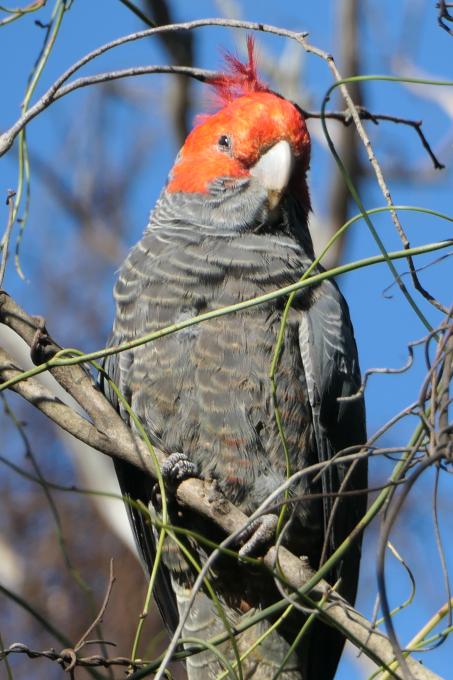 Hi all
Hi all
 Hi all,
I've also been enjoying the course. I've been bird watching for a few years but felt I needed a bit of structure to help me improve my skills and knowledge. I think I might be the only student so far posting from Australia! So I thought I'd show you some typical Aussie cockatoos - big loud and gorgeous birds. The gang gang (male) , the sulphur crested and lastly the biggest in my area of south west Australia - the yellow-tailed black cockatoo. I'm enjoying learning about North American birds too.
Thanks Marie
Hi all,
I've also been enjoying the course. I've been bird watching for a few years but felt I needed a bit of structure to help me improve my skills and knowledge. I think I might be the only student so far posting from Australia! So I thought I'd show you some typical Aussie cockatoos - big loud and gorgeous birds. The gang gang (male) , the sulphur crested and lastly the biggest in my area of south west Australia - the yellow-tailed black cockatoo. I'm enjoying learning about North American birds too.
Thanks Marie 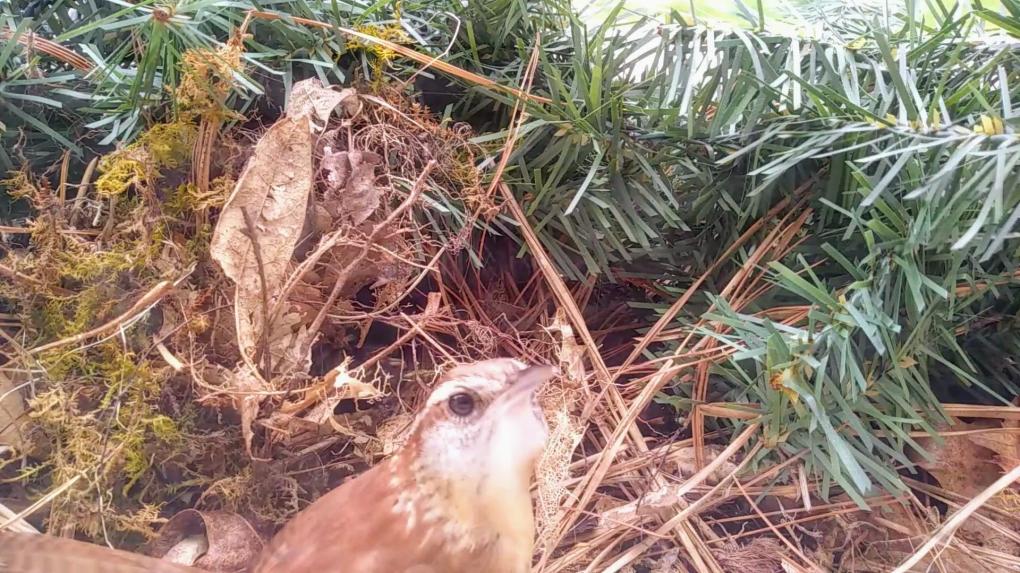 One of my new favorites - Carolina Wren. 1st time seen in our yard (Cape Cod, MA) last year. Found this nest in our planter box outside our front window w/ 3 - 4 chicks inside (hard to make out but just left and above the adults head - can see chick beak).
One of my new favorites - Carolina Wren. 1st time seen in our yard (Cape Cod, MA) last year. Found this nest in our planter box outside our front window w/ 3 - 4 chicks inside (hard to make out but just left and above the adults head - can see chick beak). 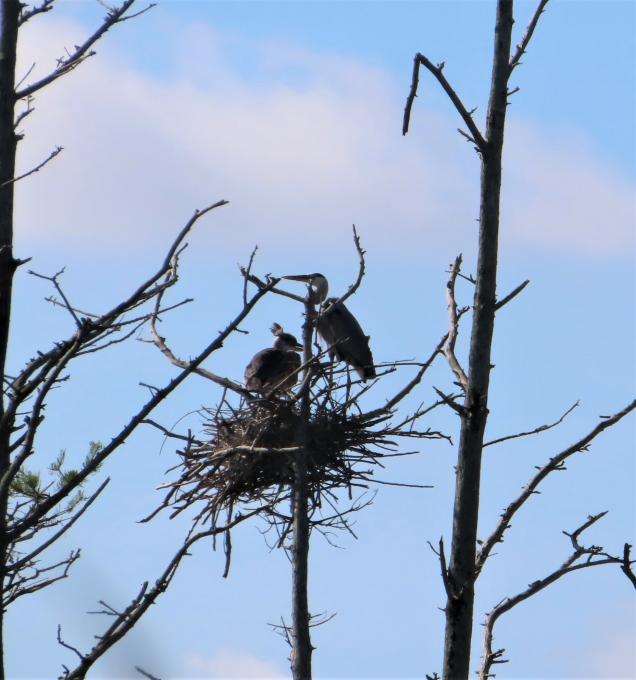
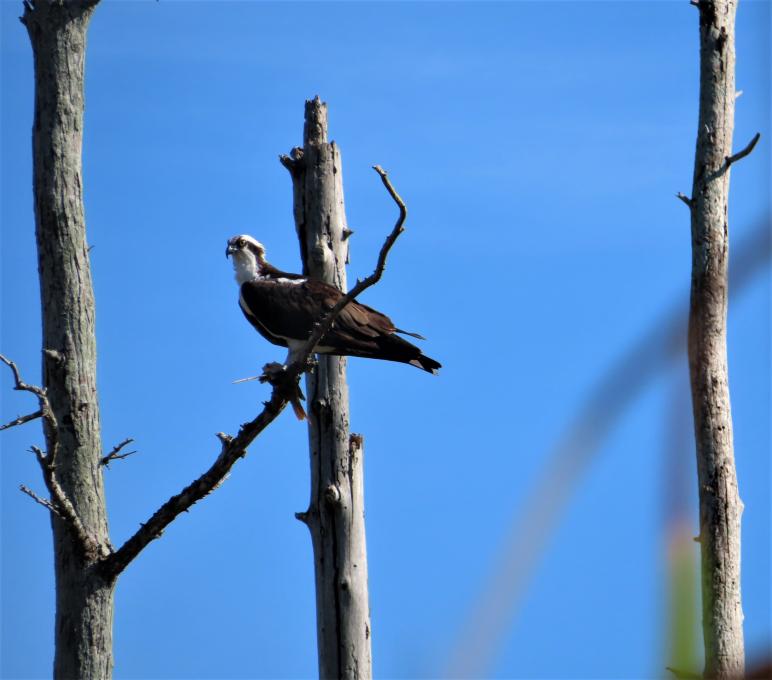
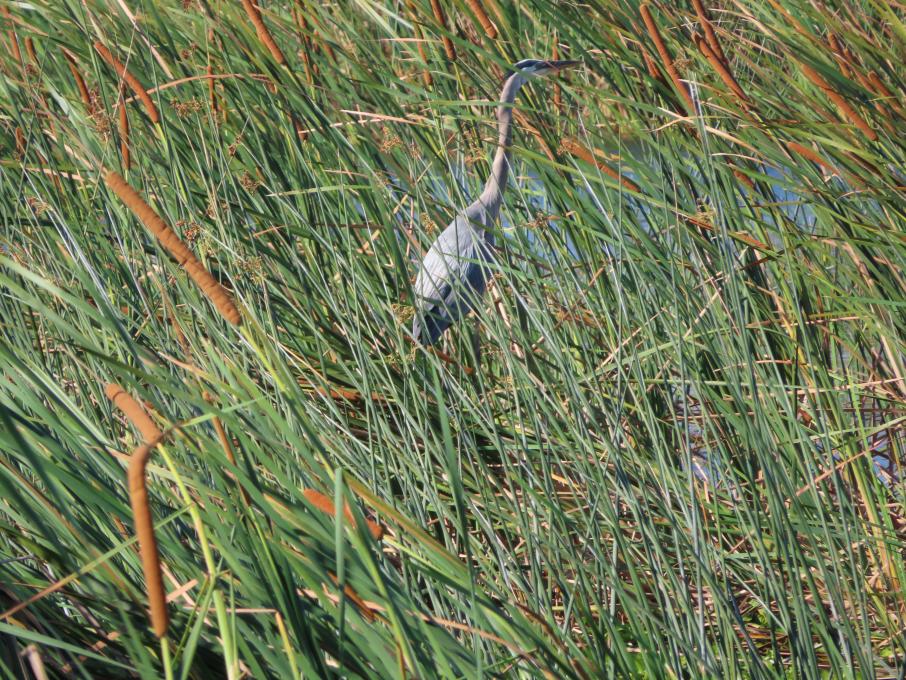
 oves are not great nest builders. However, they more than make up for that as parents. I mowed my lawn twice during the incubation period, and the female never moved off the nest. One night, we had a very strong front move through with high winds. I was concerned because the nest (in the fern) was supported by a hook on the deck. The wind rocked the fern back and forth, but the male never moved off the nest. I was blessed to watch the two baby doves grow, and be feed by both parents. They have now left the nest, and are staying under low hanging vegetation, and the mother still visits. I think she's still feeding them, and they are definitely getting bigger & exercising their wings for short trial flights. Bottom line.....I'm leaving the fern out with the abandon nest hoping they will select it again. They not only 'hooked' me on Mourning Doves; they also hooked me on bird watching! My many thanks to the Bird Academy for this opportunity, and I've recommended it to several friends and family members. ~ Jeff
oves are not great nest builders. However, they more than make up for that as parents. I mowed my lawn twice during the incubation period, and the female never moved off the nest. One night, we had a very strong front move through with high winds. I was concerned because the nest (in the fern) was supported by a hook on the deck. The wind rocked the fern back and forth, but the male never moved off the nest. I was blessed to watch the two baby doves grow, and be feed by both parents. They have now left the nest, and are staying under low hanging vegetation, and the mother still visits. I think she's still feeding them, and they are definitely getting bigger & exercising their wings for short trial flights. Bottom line.....I'm leaving the fern out with the abandon nest hoping they will select it again. They not only 'hooked' me on Mourning Doves; they also hooked me on bird watching! My many thanks to the Bird Academy for this opportunity, and I've recommended it to several friends and family members. ~ Jeff  The material so far has been helpful and I look forward to the rest of the course. We live close to the river and a nesting site for a Raven pair. Over the years we have watched their antics in the wind, listened to the diversity of their calls - including their rapid "hawk, Hawk" when a hawk or eagle comes too close to home. Also, watching the training of the young birds is fascinating and entertaining.
The material so far has been helpful and I look forward to the rest of the course. We live close to the river and a nesting site for a Raven pair. Over the years we have watched their antics in the wind, listened to the diversity of their calls - including their rapid "hawk, Hawk" when a hawk or eagle comes too close to home. Also, watching the training of the young birds is fascinating and entertaining. 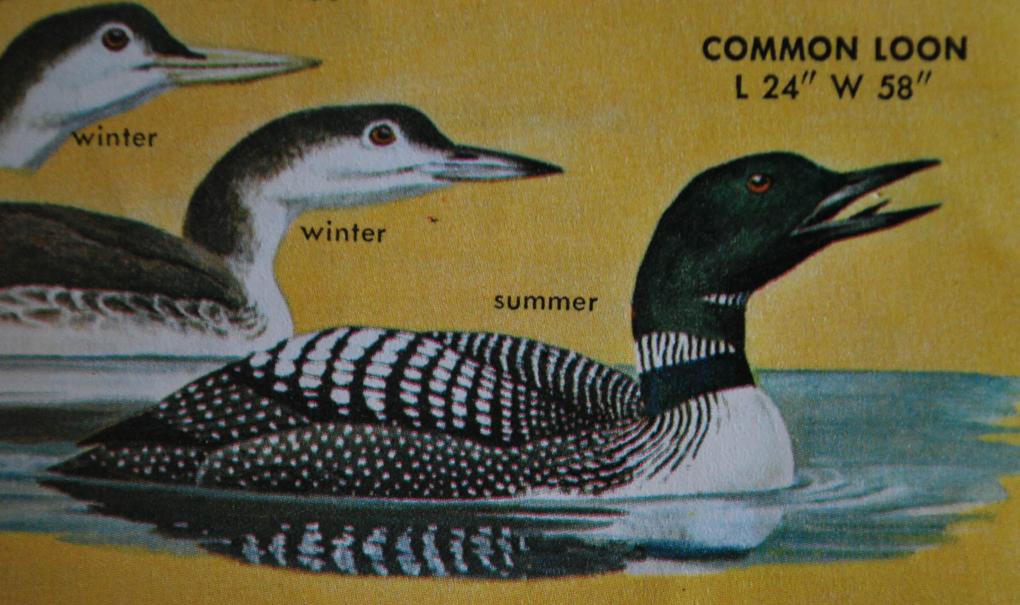 Activity 3
We went out to the ocean during the winter to see what birds we could see. We saw a relative (Pacific Loon) of my favorite the Common Loon. Being from Minnesota I fell in love early with our State Bird, and I would hear it sometimes during the night singing one of it's three beautiful songs. I never forgot those nights, and they are back at the lake now, and I can hear them again. I can't get a picture, they are so shy.
Activity 3
We went out to the ocean during the winter to see what birds we could see. We saw a relative (Pacific Loon) of my favorite the Common Loon. Being from Minnesota I fell in love early with our State Bird, and I would hear it sometimes during the night singing one of it's three beautiful songs. I never forgot those nights, and they are back at the lake now, and I can hear them again. I can't get a picture, they are so shy.
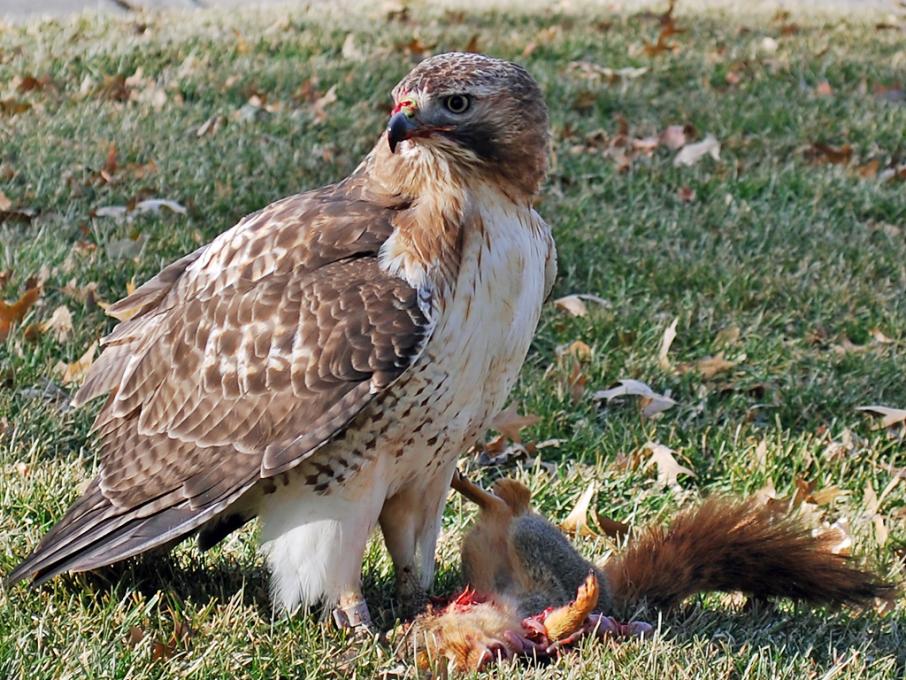 When we went to Lincoln, NE, for my aunt's funeral, I was terribly sad. I thought I would visit a museum to feel better. I did, and it helped, but as I pulled out of the parking lot, I thought I saw a crumpled paper bag in front of the museum. I kept watching, and soon realized it wasn't a bag but a Red- Tailed Hawk greedily eating a red squirrel. I stopped & got my camera and began taking pictures. He continued eating. I quietly exited the car & continued taking pictures with my long lens. After he finished his meal he flew off to watch for another red squirrel. It was as if the hawk told me good bye from my aunt.
When we went to Lincoln, NE, for my aunt's funeral, I was terribly sad. I thought I would visit a museum to feel better. I did, and it helped, but as I pulled out of the parking lot, I thought I saw a crumpled paper bag in front of the museum. I kept watching, and soon realized it wasn't a bag but a Red- Tailed Hawk greedily eating a red squirrel. I stopped & got my camera and began taking pictures. He continued eating. I quietly exited the car & continued taking pictures with my long lens. After he finished his meal he flew off to watch for another red squirrel. It was as if the hawk told me good bye from my aunt.
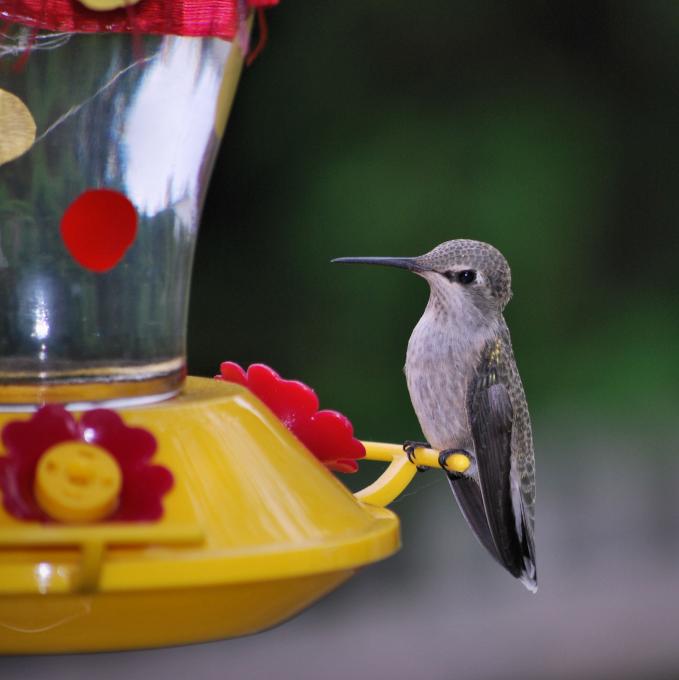 This little guy came to visit us the minute we put the hummingbird feeder out. I think it is an Anna's. She stayed on through the fall and all winter. When it got cold, we'd have two feeders ready in case one froze up. We'd run out grab the frozen one and put out the warm one up from the kitchen. The minute we's turn our back to go in, she was there, sucking away. We think her great-great-great-great grandchildren are still with us, although not as unafraid as she was, and they stay year around, just like her.
This little guy came to visit us the minute we put the hummingbird feeder out. I think it is an Anna's. She stayed on through the fall and all winter. When it got cold, we'd have two feeders ready in case one froze up. We'd run out grab the frozen one and put out the warm one up from the kitchen. The minute we's turn our back to go in, she was there, sucking away. We think her great-great-great-great grandchildren are still with us, although not as unafraid as she was, and they stay year around, just like her.  I think this may be a Gray Jay seen while walking along the shore of Lake Ontario , near the Humber River close to Toronto, Ontario!
I think this may be a Gray Jay seen while walking along the shore of Lake Ontario , near the Humber River close to Toronto, Ontario! 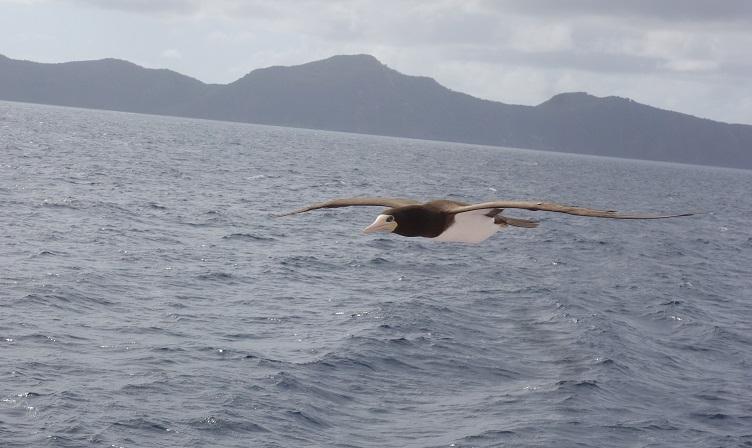 We saw this Magnificent Frigatebird swooping around our ferry coming from Bequia Island to St. Vincent in the Caribbean in Feb.2019 -it seemed to be following the Ferry and performing divebombs into the sea for fish! magnificent to watch!
We saw this Magnificent Frigatebird swooping around our ferry coming from Bequia Island to St. Vincent in the Caribbean in Feb.2019 -it seemed to be following the Ferry and performing divebombs into the sea for fish! magnificent to watch!
 I think this is a Baltimore Oriole that I saw last summer in my friend's garden by Lake Ontario. (Bowmanville).Ontario.
I think this is a Baltimore Oriole that I saw last summer in my friend's garden by Lake Ontario. (Bowmanville).Ontario. 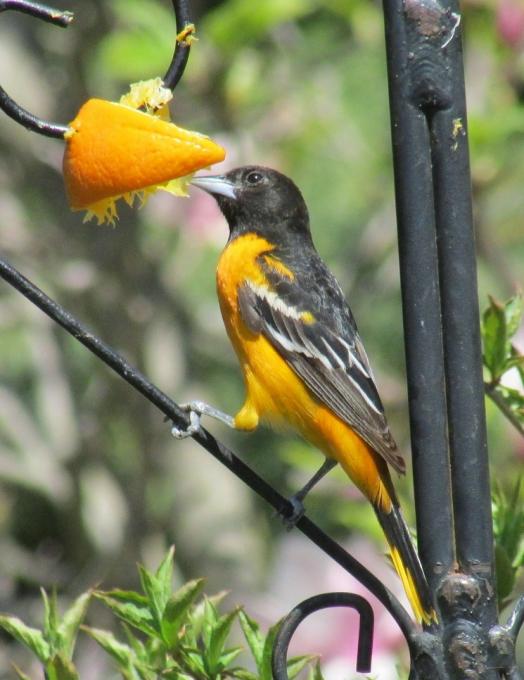 I think this is a Baltimore Oriole that I saw last summer in my friend's garden by Lake Ontario. (Bowmanville).Ontario.
I think this is a Baltimore Oriole that I saw last summer in my friend's garden by Lake Ontario. (Bowmanville).Ontario. 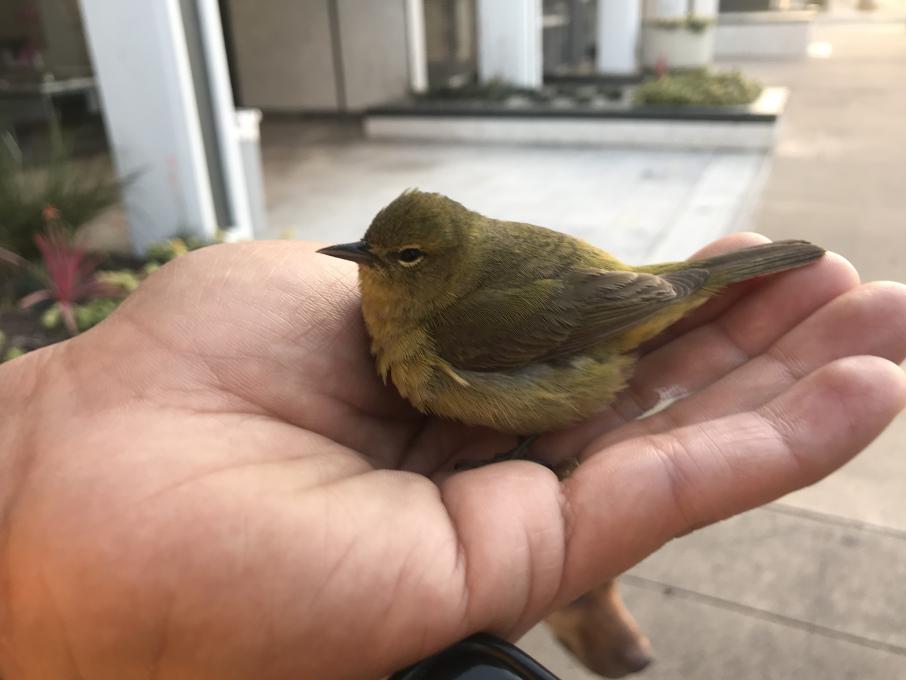


 I have been learning on my own since about December 2018 when I purchased a dslr camera wanting to get into wildlife and landscape photography. I bought a larger telephoto lens to try to photograph the January 2019 super blood wolf moon and thought it would be good for wildlife because you can't always get close to wildlife for pictures. I took that lens out to the spillway near me(the whole area is swampland) and my very first pictures were of an American Kestrel. Turns out Kestrels are camera shy. I took the best pictures I could then realized "woah, that bird that I thought was just a pigeon or some other common drab bird is actually blue and orange and tiger striped and really cool looking!". From there, I began realizing just how diverse wildlife right here around me really is - birds and insects and plants and mammals and everything. The self paced discovery has been a huge motivation to keep exploring and learning. This course, thus far, has been a review of what I have learned of birds over the past year and a half roughly. I wish, however, that I had found it sooner as the content is rich, collected, and well explained tailored for someone who's just starting to delve into the mysteries of the world around us. Cornell lab's Merlin app is hugely useful for identifying birds as is Audubon's field guide app. eBird app is also useful and contributes to a research database though you should get a little experience with identifying birds before you start as identifications can be tricky (as I'm learning) and incorrect identifications might skew the research data. For those interested in more than just birds, I highly recommend iNaturalist app and website. It is also contributing to a research database but only submits entries as research grade after someone else in the community identifies or agrees with your identification of the species you post about. It and it's community is exception at helping you discover the id of what you are looking at whether bird or bug or mammal or plant or tree or fungus or whatever and does so remarkably with photos from camera or phone alike often times getting you feedback with a day or two and occasionally within hours.
I have been learning on my own since about December 2018 when I purchased a dslr camera wanting to get into wildlife and landscape photography. I bought a larger telephoto lens to try to photograph the January 2019 super blood wolf moon and thought it would be good for wildlife because you can't always get close to wildlife for pictures. I took that lens out to the spillway near me(the whole area is swampland) and my very first pictures were of an American Kestrel. Turns out Kestrels are camera shy. I took the best pictures I could then realized "woah, that bird that I thought was just a pigeon or some other common drab bird is actually blue and orange and tiger striped and really cool looking!". From there, I began realizing just how diverse wildlife right here around me really is - birds and insects and plants and mammals and everything. The self paced discovery has been a huge motivation to keep exploring and learning. This course, thus far, has been a review of what I have learned of birds over the past year and a half roughly. I wish, however, that I had found it sooner as the content is rich, collected, and well explained tailored for someone who's just starting to delve into the mysteries of the world around us. Cornell lab's Merlin app is hugely useful for identifying birds as is Audubon's field guide app. eBird app is also useful and contributes to a research database though you should get a little experience with identifying birds before you start as identifications can be tricky (as I'm learning) and incorrect identifications might skew the research data. For those interested in more than just birds, I highly recommend iNaturalist app and website. It is also contributing to a research database but only submits entries as research grade after someone else in the community identifies or agrees with your identification of the species you post about. It and it's community is exception at helping you discover the id of what you are looking at whether bird or bug or mammal or plant or tree or fungus or whatever and does so remarkably with photos from camera or phone alike often times getting you feedback with a day or two and occasionally within hours. 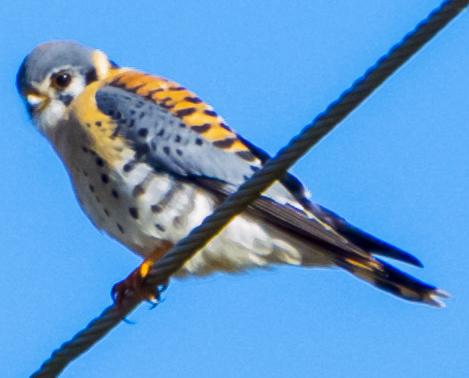
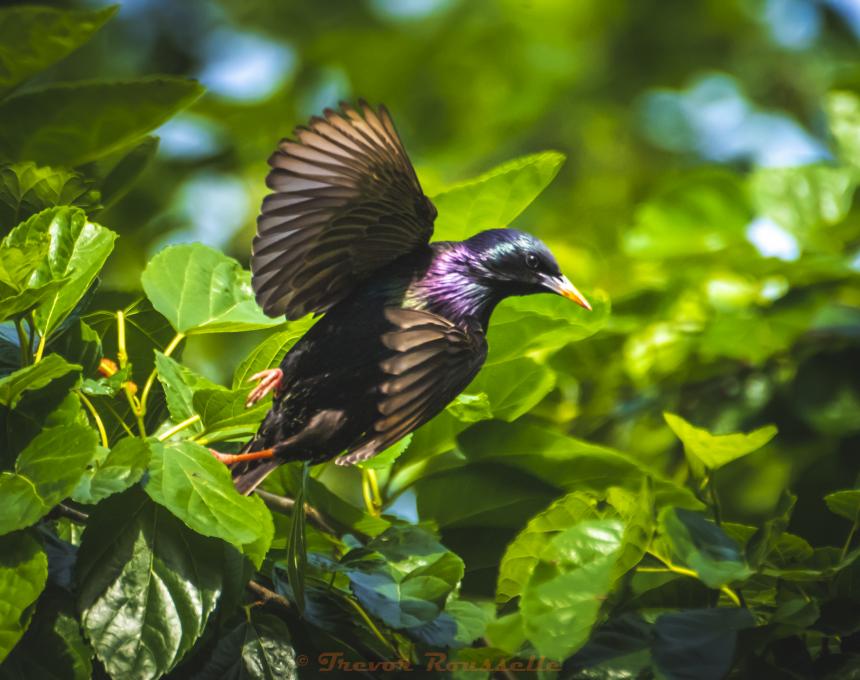
 I have been learning on my own since about December 2018 when I purchased a dslr camera wanting to get into wildlife and landscape photography. I bought a larger telephoto lens to try to photograph the January 2019 super blood wolf moon and thought it would be good for wildlife because you can't always get close to wildlife for pictures. I took that lens out to the spillway near me(the whole area is swampland) and my very first pictures were of an American Kestrel. Turns out Kestrels are camera shy. I took the best pictures I could then realized "woah, that bird that I thought was just a pigeon or some other common drab bird is actually blue and orange and tiger striped and really cool looking!". From there, I began realizing just how diverse wildlife right here around me really is - birds and insects and plants and mammals and everything. The self paced discovery has been a huge motivation to keep exploring and learning. This course, thus far, has been a review of what I have learned of birds over the past year and a half roughly. I wish, however, that I had found it sooner as the content is rich, collected, and well explained tailored for someone who's just starting to delve into the mysteries of the world around us. Cornell lab's Merlin app is hugely useful for identifying birds as is Audubon's field guide app. eBird app is also useful and contributes to a research database though you should get a little experience with identifying birds before you start as identifications can be tricky (as I'm learning) and incorrect identifications might skew the research data. For those interested in more than just birds, I highly recommend iNaturalist app and website. It is also contributing to a research database but only submits entries as research grade after someone else in the community identifies or agrees with your identification of the species you post about. It and it's community is exception at helping you discover the id of what you are looking at whether bird or bug or mammal or plant or tree or fungus or whatever and does so remarkably with photos from camera or phone alike often times getting you feedback with a day or two and occasionally within hours.
I have been learning on my own since about December 2018 when I purchased a dslr camera wanting to get into wildlife and landscape photography. I bought a larger telephoto lens to try to photograph the January 2019 super blood wolf moon and thought it would be good for wildlife because you can't always get close to wildlife for pictures. I took that lens out to the spillway near me(the whole area is swampland) and my very first pictures were of an American Kestrel. Turns out Kestrels are camera shy. I took the best pictures I could then realized "woah, that bird that I thought was just a pigeon or some other common drab bird is actually blue and orange and tiger striped and really cool looking!". From there, I began realizing just how diverse wildlife right here around me really is - birds and insects and plants and mammals and everything. The self paced discovery has been a huge motivation to keep exploring and learning. This course, thus far, has been a review of what I have learned of birds over the past year and a half roughly. I wish, however, that I had found it sooner as the content is rich, collected, and well explained tailored for someone who's just starting to delve into the mysteries of the world around us. Cornell lab's Merlin app is hugely useful for identifying birds as is Audubon's field guide app. eBird app is also useful and contributes to a research database though you should get a little experience with identifying birds before you start as identifications can be tricky (as I'm learning) and incorrect identifications might skew the research data. For those interested in more than just birds, I highly recommend iNaturalist app and website. It is also contributing to a research database but only submits entries as research grade after someone else in the community identifies or agrees with your identification of the species you post about. It and it's community is exception at helping you discover the id of what you are looking at whether bird or bug or mammal or plant or tree or fungus or whatever and does so remarkably with photos from camera or phone alike often times getting you feedback with a day or two and occasionally within hours. 